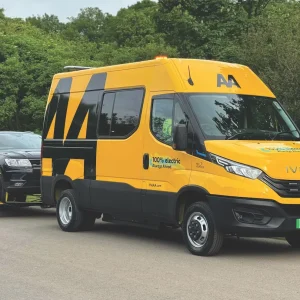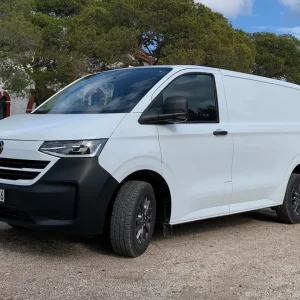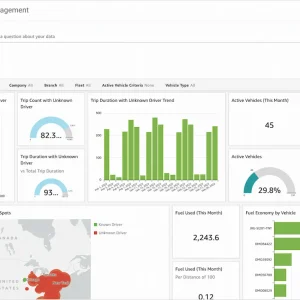LDV
 One of the strongest cards LDV used to be able to play in what became an increasingly tired-looking pack was the availability of the 17-seater Convoy minibus.
One of the strongest cards LDV used to be able to play in what became an increasingly tired-looking pack was the availability of the 17-seater Convoy minibus.
Wide and tall, it offered plenty of room for even the biggest and beefiest of sports teams, and was a popular choice as a consequence; so when What Van? was told that engineering problems meant that Maxus, Convoy's successor, wouldn't be available as a 17-seater, we were astonished.
These engineering problems have been resolved, however, possibly thanks to the investment that LDV's new owner GAZ is making in the Birmingham-based business. Maxus is up for grabs not just as a 17-seater minibus but as a 10-, 12- and 15-seater too, and the manufacturer is clearly determined to capture a significant slice of the passenger-carrying market.
It's up against some stiff competition. Last year saw an almost bewildering number of panel van launches. Ford debuted a new Transit, Mercedes unveiled a new Sprinter, Volkswagen introduced Crafter, its LT replacement, and there were new offerings from Citroën, Fiat, Peugeot, Iveco, Renault and Vauxhall among others.
When a new van of this size appears it's the volume-selling models that tend to turn up at dealerships first, with the more specialised variants — chassis double cabs, 5.0-tonners and so on — slipping into the market over the following weeks or months. Minibuses fall into the specialised category so they've taken a while to make their presence felt, but the battle for business between manufacturers is beginning to hot up.
A minibus is defined as a vehicle constructed or adapted to carry in excess of eight but not more than 16 seated occupants, not counting the driver.
While most manufacturers offering minibuses in the UK tend to source them from bodybuilders as conversions, LDV is unusual in putting them together on its assembly line; unusual, but not unique. Ford for instance does the same thing and is energetically promoting the passenger-carrying version of the latest Transit.
Ford Transit
 What Van?'s Minibus of the Year in 2006, Transit comes with disc brakes all round, ABS and Electronic Stability Programme as standard on most models. It's our strongly-held view that ESP should be mandatory on all minibuses.
What Van?'s Minibus of the Year in 2006, Transit comes with disc brakes all round, ABS and Electronic Stability Programme as standard on most models. It's our strongly-held view that ESP should be mandatory on all minibuses.
Transit minibus is on offer as a nine-, 12-, 15- or 17-seater. The two smallest models are front-wheel drive and powered by a 2.2-litre diesel generating either 110 bhp or 130 bhp. Rear-wheel drive, their stablemates come with a 2.4-litre diesel at 100 bhp, 115 bhp or 140 bhp.
All the engines bar the 110 bhp 2.2-litre are fitted with a dual mass flywheel. By dampening vibrations it helps cut gear rattle and body boom; welcome news for passengers who want a quiet, comfortable ride.
Some versions, the 12-seater for instance, have both near- and offside sliding side passenger doors, and they all come with twin rear doors.
Transit 12-. 15- and 17-seater minibuses carry something that will be familiar to many minibus owners and users; a Schedule 6 kit. It includes a first aid box plus body decals showing whereabouts it is stowed, a fire extinguisher, a grab handle to aid entry through the sliding side passenger door and decals giving the passenger capacity and indicating the emergency exit.
Safety
Like many, if not most, of its competitors Transit is built to M1 passenger car safety standards even though this is not a legal requirement.
To comply with M1 a vehicle's seats, seat belts and related mountings must be capable of standing up to a 20g deceleration from 30mph without breaking loose. That's twice what is needed to achieve certification to M2; the minimum legal standard minibuses must meet.
Belt-up
 While Ford makes a virtue of the fact that all Transit minibus seats are equipped with lap-and-diagonal belts, the fact is that all minibuses grossing at up to 3.5 tonne and first used on or after 1 October 2001 must have them fitted to all forward-facing seats.
While Ford makes a virtue of the fact that all Transit minibus seats are equipped with lap-and-diagonal belts, the fact is that all minibuses grossing at up to 3.5 tonne and first used on or after 1 October 2001 must have them fitted to all forward-facing seats.
So must minibuses tipping the scales at above that weight — 17-seaters may be plated at up to 4.2 tonnes or more to avoid overloading — unless an energy-absorbing surface is situated in front of the seat concerned. If that's the case, then a lap belt can be provided instead.
No matter what the age of a minibus is, it must be fitted with seat belts if it's going to be used to transport children.
Those belts, and the seats the kids are sitting on, must be professionally installed, not held in place with rusty coach bolts and penny washers. If you've any doubts, then you should check with a dealer or a bodybuilder that the job's been done correctly.
Automatic Choice
Transit and Maxus share one big drawback when it comes to minibus work. Neither of them is available with an automatic or a semi-automatic gearbox and that gives vehicles such as Mercedes-Benz's Sprinter and VW's Crafter an advantage. The former can be ordered as a full automatic, the latter with the semi-auto Shiftmatic 'box.
Volkswagen
VW is attempting to make inroads into the UK minibus market and has appointed three firms as accredited converters; Advanced Vehicle Builders, Minibus Options and Mellor Coachcraft.
All three have developed Crafter-based minibuses. Advanced has even launched a web site dedicated to its conversions.
One of its most impressive it's come up with is a wheelchair-accessible 17-seater based on the Crafter CR50 long-wheelbase maxi high roof. Twelve of the rear seats are secured to aluminium tracks by quick-release fixings and can be removed so that up to six people in wheelchairs can be transported.
Minibus Options offers an accessible Crafter too as a 12- 15-, or 17-seater while Mellor has designed a coach-built Crafter — not all minibuses are van conversions — using grp panels hung on a stainless steel frame. In accessible guise it can carry as many as eight passengers in wheelchairs. Oughtred and Harrison is an accredited converter too.
Renault & Vauxhall
Renault's Master is available with a semi-automatic gearbox — Vauxhall's Movano can be specified with one as well — and that makes its 17-seater Master minibus especially appealing. Its range also includes a 16-seater and a nine-seater Trafic minibus.
Vauxhall will supply you with either a nine- or a 12-seater Vivaro and with a 15-, 16-, or 17-seater Movano.
Rules & Regs
All minibuses registered since 1 January 2005 must be fitted with a road speed limiter by 1 January 2008, or right now if they're going to be used outside the UK. Older minibuses registered between 1 October 2001 and 31 December 2004 must be equipped with one regardless of where they are going to be used. The limiter restricts the vehicle's top speed to 62mph.
Tachographs
 At the time of writing tachographs only had to be fitted and used if the minibus was going to be used on trips to other EU countries. That will still be the case in the future, but from 11 April this year they'll have to be fitted to minibuses destined for UK domestic work only as well.
At the time of writing tachographs only had to be fitted and used if the minibus was going to be used on trips to other EU countries. That will still be the case in the future, but from 11 April this year they'll have to be fitted to minibuses destined for UK domestic work only as well.
Drivers will have to comply with the heavy truck Drivers Hours regulations as they are already obliged to do if they take a minibus across the Channel.
There are, however, some important exceptions. A tachograph won't, for example, be required if the vehicle is used exclusively for the non-commercial carriage of passengers, points out Advanced, or by a local authority to transport the elderly or disabled.
“Vehicles registered from 11 April will require a tachograph fitted from new,” says an Advanced spokesman. “Those registered prior to this date will have to have a tachograph fitted retrospectively and the owner will have until 31 December to comply.”
Don't forget that tachographs installed in new vehicles are digital and oblige the driver to insert a smartcard issued by the DVLA. Minibuses registered prior to 1 May 2006 can be retro-fitted with an old-style analogue tachograph, however, points out Advanced. It uses a waxed chart to record driving activities.
PSV
Depending on the sort of work it's on any vehicle built to carry nine or more passengers for hire or reward may be categorised as a Public Service Vehicle (PSV); and hire or reward doesn't only describe scenarios where the passenger purchases a ticket from the driver.
Hotel minibuses fall into the hire or reward category for example. People staying at a hotel are allowed to travel in them because they're paying for their room, so the owner of the vehicle is enjoying a financial benefit.
Minibuses used to take workers from a builder's yard to a construction site do not, however, so long as no deduction is made from their wages.
If you're operating a PSV then you must either hold a PSV Operator's Licence or a community bus permit. The former is the same as the O licence held by companies that run full-sized coaches and is granted by an official known as the Traffic Commissioner. He or she also grants community bus permits under Section 22 of the Transport Act 1985.
They're intended for organisations operating local services using buses with no more than 16 passenger seats. The service must be non profit-making and provided to benefit the community.
Some operators may have to hold a permit granted under Section 19 of the 1985 Act. They're extended to schools using minibuses to transport pupils, just so long as they are not doing so at a profit. They can also be granted to churches and welfare groups.
Grandfather Rights
Anybody who passed a car driving test before 1 January 1997 is allowed behind the wheel of a 17-seater minibus.
Anybody who got their licence after that date is restricted to vehicles with no more than eight passenger seats and tipping the scales at no more than 3.5 tonne. They're obliged to take a separate test if they want to drive anything bigger.
Anyone who wants to drive a PSV must take a separate test to obtain a Passenger Carrying Vehicle licence.
You can take to the highway in a minibus that comes under the permit scheme without being a PCV licence holder, but you must be at least 21, have held a full ordinary licence for at least two years and the minibus must gross at no more than 3.5 tonne.
Nor must you accept any financial reward other than expenses or compensation for lost earnings for the work you're doing.
Driver Training
Driving a big minibus isn't like driving a car and even experienced minibus drivers can benefit from additional training.
The Royal Society for the Prevention of Accidents (RoSPA) can provide details of courses. They're well worth investigating.
One last thought. Remember that vehicles with nine or more seats qualify for a 100 per cent discount on the London congestion tax if they are registered with Transport for London. Click here for more details.





